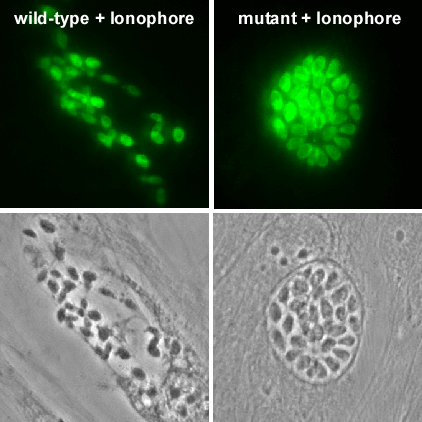
Research Interests
Our specific research questions include:
-
How do parasites physically divide by internal budding?
-
What underlies the (modular) cell division plasticity in Apicomplexa
-
What is the function of the basal complex in mature parasites?
-
How do parasites secrete organelles in a calcium dependent fashion?
-
What changes underlie lab-adaptation of parasites?

Toxoplasma gondii
The protozoan parasite Toxoplasma gondii is a member of the phylum Apicomplexa and can cause severe disease in humans. This parasite is easily grown and manipulated in vitro and has in recent years developed as a safe and versatile model for other apicomplexan parasites (e.g. malaria). We are using and developing forward, reverse and functional genetic tools using enzymatic as well as fluorescent protein reporter assays in combination with cell sorting and fluorescence microscopy to learn more about the parasite’s cell biology.

Cell Division
Toxoplasma divides through a unique internal budding mechanism producing two daughters per division round. Toxoplasma’s binary division is the simplest division strategy among the Apicomplexa and is why we use it as a model. A downside is that everything happens at the same time and therefore we are now also working with Sarcocystis neurona, which makes large polyploid cells before committing to budding. We are currently targeting this question by comparative cell division of Apicomplexa using a single cell RNA seq (scRNA-seq) approach across 5 different division modes. This is an exciting 3-way collaboration with Dr. Manoj Duraisingh at Harvard (Plasmodium and Babesia) and Dr. Kourosh Zarringhalam at UMass Boston (Computational Biology)

Host Cell Invasion
2+
Since no parasite replication takes place outside a host cell, successfully invading a host cell is critical to survival of the parasite. The asexual tachyzoite stages of Toxoplasma are able to invade any nucleated cell from any warm-blooded animal. This wide host range sets it apart from the typical apicomplexan parasite which has a narrow range (e.g. the malaria causing Plasmodium merozoites only invade erythrocytes from a single host). The basic mechanism of parasite-powered host cell invasion is largely conserved across Apicomplexa, but Toxoplasma’s wide host range and easy lab cultivation make it easily accessible model. Our current interest lies in identifying and understanding through which proteins Ca exerts its function in organelle exocytosis.

